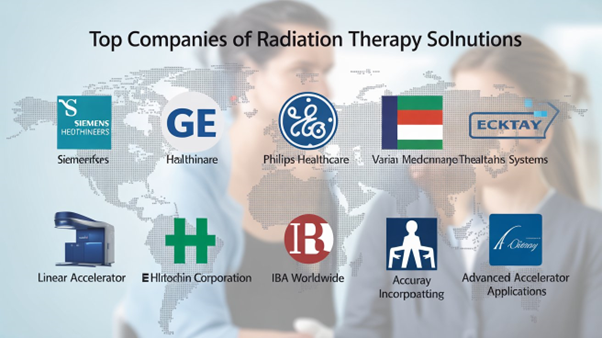Top Companies in the World Offering Radiation Therapy Solutions
Author:
Intellectual Market Insights Research
Published Date:
05 Oct 2025

Radiation Therapy for Cancer: Treatments, Types, Applications, and Regional Analysis
Radiation Therapy Overview
Radiation therapy uses ionizing radiation to destroy or control cancer cells. It’s typically delivered by a linear accelerator and may be applied externally—by directing high-energy beams at the tumor from outside the body—or internally, by placing radioactive materials inside the body near the cancer site.
When used in cancer treatment, radiation damages the DNA of cancer cells, preventing them from multiplying. Radiation therapy is broadly categorized into two types: external-beam radiation therapy (EBRT) and internal-beam radiation therapy (IBRT), depending on the position of the radiation source.
Also known as radiotherapy, RT, RTx, or XRT, this treatment can be used on its own or combined with surgery and chemotherapy. EBRT uses a machine called a linear accelerator (LINAC), while IBRT places radioactive material directly into or near the tumor.
Types of Radiation Therapy
There are two main types of radiation therapy:
- External Beam Radiation Therapy (EBRT) – The most common method, EBRT delivers high-energy beams from outside the body to the cancer site using a linear accelerator. Treatments are typically spread over several sessions across weeks.
- Internal Beam Radiation Therapy (IBRT) – Also known as brachytherapy, this method places radioactive material directly inside the body near the tumor. A related approach, Intraoperative Radiation Therapy (IORT), is given during surgery for early-stage cancers like breast cancer.
Market Overview
According to IMIR Market Research, Global Radiotherapy Market size was valued at USD 5.92 Billion in 2021 and is projected to reach USD 8.13 Billion by 2028, growing at a CAGR of 4.65% from 2021 to 2028 according to a new report by Intellectual Market Insights Research.
Key growth drivers include:
- The rising global incidence of cancer (expected to reach 24 million cases by 2030, WHO).
- Increasing adoption of advanced techniques like proton therapy, which precisely targets tumors while sparing healthy tissues.
However, high treatment costs—USD 32,000 for proton therapy vs. USD 18,000 for conventional therapy (University of Michigan, 2018)—remain a barrier, particularly in developing regions.
Applications of Radiation Therapy
Radiation therapy is used to treat various cancers, including:
- Breast, lung, prostate, and skin cancer
- Brain and head & neck cancers
- Cervical, uterine, and ovarian cancers
It’s also used to shrink tumors, relieve pain, and treat some non-cancerous conditions.
Common side effects: fatigue, skin irritation, nausea.
Rare complications: secondary cancers or heart and lung problems.
Lifetime Radiation Dose Limits
The American College of Radiology (ACR) recommends a maximum occupational dose of 50 mSv per year for radiation workers. The U.S. OSHA sets the same limit (5 rem/year). Although many developing nations lack strict regulations, growing awareness of radiation safety is expected to shape future market growth.
Cost of Radiation Therapy
Treatment costs range from USD 10,000 to 50,000, depending on cancer type, stage, and treatment plan. Most health insurers cover part of the expense, but patients should confirm details with their provider before starting therapy.
Diet and Lifestyle During Treatment
No strict dietary restrictions exist during radiation therapy, but maintaining a balanced diet, staying hydrated, and eating small, frequent meals helps manage fatigue and nausea. Consultation with a dietitian is recommended.
Patients who are physically able may continue working, provided employers allow flexibility. Fatigue and mild side effects may require adjustments to the work schedule.
Top 10 Radiation Therapy Companies in the World
- Siemens Healthineers (Germany) – Revenue: USD 19.50 Billion
Offers a full range of imaging and radiation solutions including CT, MRI, PET, and angiography systems. - GE Healthcare (UK) – Revenue: USD 19.49 Billion
Provides integrated radiation therapy hardware, software, and diagnostic imaging systems. - Philips Healthcare (Netherlands) – Revenue: USD 18.41 Billion
Supplies radiation therapy systems such as Elekta Linear Accelerators and Flexitron HDR Brachytherapy Afterloader. - Varian Medical Systems (USA) – Revenue: USD 3.21 Billion
Specializes in linear accelerators, proton therapy systems, and cancer treatment software. - Elekta (Sweden) – Revenue: USD 1.65 Billion
Known for the Leksell Gamma Knife and Elekta Synergy systems for cancer and neurological disorders. - Hitachi Medical Corporation (Japan) – Revenue: USD 1.12 Billion
Provides advanced linear accelerators, CT simulators, and brachytherapy solutions. - IBA Worldwide (Belgium) – Revenue: USD 528 Million
Developer of ProteusONE™ proton therapy and Flexintensity™ systems for personalized cancer treatment. - Accuray Incorporated (USA) – Revenue: USD 439.27 Million
Creator of CyberKnife and TomoTherapy systems for precise, robotic cancer treatment. - Advanced Accelerator Applications (France) – Revenue: USD 443.8 Million
Focuses on radiopharmaceuticals, including Lutathera and Zevalin, for targeted cancer therapy. - Nordion Inc. (Canada) – Revenue: USD 235.6 Million
Provides EBRT and brachytherapy products along with radiation safety and planning services.
Regional Market Analysis
North America – Dominates the market due to high cancer prevalence, strong healthcare infrastructure, and early adoption of advanced therapies.
Europe – Moderate growth driven by established healthcare systems and increasing cancer incidence.
Asia Pacific – Fastest-growing region due to rising awareness, expanding healthcare access, and increasing cancer rates.
Latin America – Moderate growth supported by improving cancer care facilities.
Middle East & Africa – Slower growth due to limited healthcare resources and lower awareness levels.
Bottom Line
Radiation therapy remains one of the most effective cancer treatment methods. With rising cancer rates and ongoing advancements in precision radiotherapy and proton therapy, the global radiation therapy market is poised for steady expansion through 2030.



